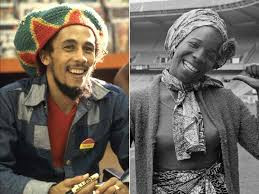
With her fourth studio album titled We Must Carry On, Alfarita Marley typifies that by continuing to breathe life into the legacy of her late husband, reggae superstar, Bob Marley.
Having endured personal and romantic hardships — many of which are detailed in her book, No Woman No Cry: My Life with Bob Marley, the memoir’s title is borrowed from one of Bob’s most beloved songs — No Woman, No Cry — a tribute written, in part, to console Rita during hard times.
Rita’s radiance is that her beauty, grace and resilience were understated. She lived in a whirlwind of rehearsals, sprinting children, and concert performances.
She found herself immersed in show business, a realm in which one is noticed by how rambunctious, audacious and glamorous they are. Knowing this, it was easy to overlook those qualities and assume they didn’t exist.
As one reads her memoir, it is illuminated subtly that the candle that burns twice as bright, burns half as long. Therefore, her muted radiance, while often overlooked, proved to stand the test of time in the grand context of legacy.
Rita is an exceptionally beautiful woman. She has a rich melanated complexion, and long cascading locs that crown her demeanor regally. Often times, her beauty went unnoticed because she grew up in a colorist society, where lighter skin was prized — a legacy of Jamaica’s stratified, colonial past.
She writes: “Because I was very dark skinned, the kids in school called me “blackie tootus” (black and shiny, with very white teeth). I learned discrimination early and underestimated my own value because of my colour. Jamaica has a long history of colour consciousness and racial struggle.”
For context, Jamaica is a former British colony, with centuries of slavery to accompany it. During this period, the plantation system that was rife bred an internal hierarchical structure, in which mixed race (lighter-skinned) individuals were often given preferential treatment (for example, house work versus field work).
- Edutainment mix: The artist in the child policy formulation context
- Edutainment mix: The artist in the child policy formulation context
- In the groove: Bob Marley continues to rule from the grave
- Mambo Chivero Zim’s new mbira music ambassador
Keep Reading
Post-emancipation, that hierarchy remained embedded in society — in schools, jobs, media, and beauty ideals. This historical backdrop negatively affected women such as Rita, as beauty standards favoured light skin, thin noses, loosely curled, or straight hair.
Even as she grappled with the revolving doors of Bob’s career — and the infidelity fame brought — she held onto her identity, she writes: “Back then, as today, I knew I was black and beautiful—and I was proud. Like the slogan: ‘Say it loud, I am black and I am proud!’ What else could I be but black and proud around all the light-skinned ‘book pretty’ girls?”
One thing that rings true about Rita is that her ability to love and cherish herself was strongly facilitated by the lack of external validation. Her self-love became more than surface level affirmation, it was a revolutionary force that watered her when the world wouldn’t do so.
Rita embraced whatever it was that life gave to her, signifying her resilience. In the 1970s, Jamaica was boiling over with political unrest. The two dominant political parties, the PNP (People’s National Party) led by Michael Manley (left leaning, aligned with socialism and Cuba), and the JLP (Jamaica Labour Party) led by Edward Seaga (more conservative, aligned with the United States) were in violent opposition.
Gangs were armed by political parties, and areas such as Trenchtown (where Rita and Bob came from) became war zones. People were killed for party allegiance. Poverty, inequality, and cold war meddling (by the US and Cuba) heightened the stakes.
In so many words, Jamaica was on the brink of a civil war. On December 5th, 1976 Manley asked Bob Marley to perform at this Smile Jamaica concert.
Marley agreed — but emphasised it was not a political endorsement. On December 3, 1976, just two days before the concert, gunmen stormed Bob’s home at 56 Hope Road. Rita Marley was shot in the head while sitting in a car. The doctors stated that her locs protected her from a fatal outcome. Bob was grazed.
This was a key definer in the depth of her resilience.
She writes: “On Sunday, though, I was on stage, singing, because Bob decided to go ahead and do the concert. Come what may, he said, they could kill him now, but he was going to do it for the people … Bob stood there, out in the open, exposed to whatever might happen, his arm in a sling, unable to play guitar. I was still in my hospital jacket, my head all bandaged up and everything. And we sang.”
This incident is a testament to Rita’s commitment not only to Bob, but to the message that Bob stood — and was willing to die — for. Peace, love, and unity was what drove Bob Marley and the Wailers, it also drove Rita’s passion.
The memoir goes in depth to describe Rita’s upbringing, Bob’s rise to fame, and his tragic death in 1981. And to her, her womanhood was inextricably tied to their love story — so much so that their love became part of her identity.
The phrase “No woman, no cry” wasn’t just the title of Bob’s song — it was a benediction over Rita’s life. Silent strengths require patience in order to see the fulfillment of their value. That, is the essence of Rita Marley.
Chambeni is an editorial writer, book enthusiast, and a member of Trevor’s Book Club. She values the transformative power of communication to foster understanding, inspire critical thought, and build meaningful connections.











